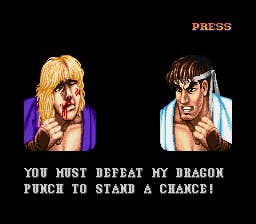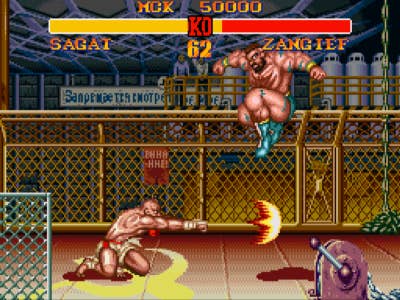Super NES Retro Review: Street Fighter II Turbo: Hyper Fighting
Join us as we review every Super NES Classic game. Next up: The best 16-bit Street Fighter game of all time. Unless you prefer Super Street Fighter II.
This article first appeared on USgamer, a partner publication of VG247. Some content, such as this article, has been migrated to VG247 for posterity after USgamer's closure - but it has not been edited or further vetted by the VG247 team.
Join us as we review all the games on the SNES Classic Mini Edition in chronological order!
One of my privileges in life was getting to watch Capcom's Street Fighter II change the gaming landscape like a well-placed Hurricane Kick. Not that I appreciated my position at first. I initially wondered why the hell the boys in my grade six class couldn't stop screaming about spending $20 worth of quarters on this "Street Fighter" thing every weekend.
I only understood what the fuss was about when I visited a friend, and watched her brother play Street Fighter II on the Super Nintendo. I was blown away by the visuals alone. "My God," I said, "I can see that karate guy's toes!"
Street Fighter II shaped the games industry by immeasurable degrees, especially its competitive side. Even though I'm a bit of a fighting game scrub, the series remains close to my heart; I have a cat named after Street Fighter's own Cammy White, and the two are equally matched for attitude.

When it became apparent Street Fighter II wasn't a passing fancy with the public, Capcom quickly started re-tooling and re-releasing the 2D fighter. These spit-and-polish jobs were less obvious in the arcade (where you just fed quarters to whatever machine was available in the laundromat, regardless of tweaks, alterations, or coffee stains), but they garnered a lot of conversation when they came to the SNES.
There was considerable scorn, too. Games writers put aside the "Why's it called Final Fantasy?" joke long enough to admonish Capcom for stalling on Street Fighter III. Fans were in on the ribbing, too. I remember seeing a piece of envelope art in GamePro Magazine wherein Bert and Ernie from Sesame Street are trying to teach a Capcom representative how to count. The representative is unable to move past the number two, leading a despondent Ernie to press a gun to his own temple.

Street Fighter II Turbo: Hyper Fighting was no joke when it came to the SNES in 1993, though, and its inclusion on the SNES Classic Edition is no joke, either. Though the initial 1992 release of Street Fighter II was a literal game-changer, Street Fighter II Turbo makes a list of improvements to the revolutionary title. Mirror matches were implemented (and, by extension, players could change the color of their fighters' clothes), the fighters' portraits were redrawn, some backgrounds were likewise gussied up, and the boss characters you face off against in the original Street Fighter II – Balrog, Vega, Sagat, and M Bison – are all playable. You can also select your match speed in Street Fighter II Turbo, allowing for blazing-fast matches that are difficult to keep up with unless you know what the heck you're doing.
Street Fighter II Turbo shares a lot in common with another popular game included on the SNES Classic: Super Mario Kart. Both are revolutionary titles that helped birth new genres, and while both seem simple when held up against newer entries in their series, there's still a great deal of fun packed in those candy-colored pixels. And even though Street Fighter II Turbo doesn't have the universal appeal of Mario Kart, its fanbase is still huge, varied, and will have a good time going back to Street Fighter II Turbo for an afternoon or two. Casuals like myself can still have a riot punching each other in the face, while more hardcore players can test themselves on the very basics. Playing a 16-bit Street Fighter game today is like sitting under a pounding waterfall. Easy to do, but a very good way to build up endurance.
(Do not sit under waterfalls to build endurance or better yourself at Street Fighter without the supervision of a senpai or sensei.)

Now, pardon me while I bear my shoulders for a flogging: Though I'm a Street Fighter fan, I'm not a disciple of the series, so I'm a bit fuzzy on why Super Street Fighter II Turbo is included on the SNES Classic in lieu of the newer, slicker Super Street Fighter II. It's easy to understand why Turbo was chosen over vanilla Street Fighter II, but speaking for myself, I'd rather have Super Street Fighter II's new characters, new stages, improved sound (forget Guile's theme, Cammy's theme goes with everything, and Fei Long's stage music is one of Street Fighter's most under-appreciated pieces), and sharper graphics.
I guess it's a little like choosing between food, water, and oxygen. As much as you need all three, you're going to check out quickly if you don't have air. All the SNES iterations of Street Fighter II are superb, but a quick glance around the series' communities reveals Turbo is the preferred entry.
I suppose it also has the most nostalgia attached to it since its release year (1993) was a real sweet spot for the SNES. It was starting to gain ground over the Sega Genesis, its library shone, and the 32-bit generation was little more than a fairy tale. With no new consoles to save up for, people felt free to splurge on an upgrade to Street Fighter II. Super Street Fighter II, however, had to compete with Mortal Kombat and hype for the PlayStation, Sega Saturn, and Nintendo 64.
One thing's for sure: Mechanically, Street Fighter II Turbo is a big jump over the original Street Fighter II. It's the furthest thing from a poor choice for the SNES Classic Edition. I look forward to marvelling at Ryu's toes again.
ConclusionBy some fans' measurement, Street Fighter II Turbo is the quintessential retro Street Fighter experience. I'd prefer Super Street Fighter II on the SNES Classic, but I guess it's ultimately like being forced to choose between petting a kitten or a puppy. Either way, I win.

